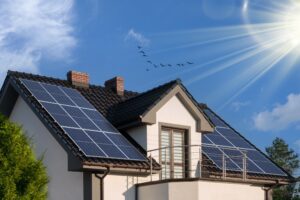If you want to generate your own electricity, integrated solar panels provide an alternative to traditional solar panels. Like standard solar panels, integrated panels go on the roof, but they’re embedded within the structure rather than sitting on top of it.
This post looks at what you need to know about integrated solar panels so you can make an informed decision on whether they could be right for your home.
We’ll cover:
- How integrated solar roof panels work.
- What types of integrated solar panels are available.
- What types of solar cells are in integrated panels.
- Advantages of integrated solar panels.
- Disadvantages of integrated solar panels.
- Whether integrated solar panels are expensive.
How Do Integrated Solar Panels Work?
Like other solar panels, roof-integrated panels use a photovoltaic (PV) system to convert light into electricity. This free energy lowers electricity costs by reducing reliance on the National Grid. Unlike energy produced by fossil fuels, solar power is eco-friendly and emits no greenhouse gases.
The difference with integrated solar panels is how they’re installed. Regular solar panels are placed on top of roof slates or tiles. This is why they’re known as on-roof panels.
Integrated solar panels – or in-roof panels – are fixed into the roof itself. This is done by:
- Removing a section of roof slates or tiles to expose the underlying batten-and-felt structure.
- Attaching plastic trays to this structure and fitting a waterproof membrane.
- Installing a set of slimline solar panels on top that sit flush with surrounding roof tiles or slates.
- Filling in the area around the panels with roof slates or tiles to create a seamless finish.
In most instances, there’s no need to modify the underlying structure of the roof.
- Create a Tailored Quote Based On Your Circumstances
- Takes Less Than 2 Minutes
- Fixed-Online Quotes

Types of Integrated Solar Panels
Common integrated solar panel systems include:
- In-roof frames. Systems such as EasyRoof Evolution and GSE are among the least costly options. This is because any industry-standard solar panel can be mounted to them. In-roof frames are suitable for around 90% of solar panels in the UK and are often used in house renovations and new builds.
- Bespoke integrated panels. Systems such as SolFit, GB-Sol, and Viridian use solar panels specifically made for in-roof systems.
Integrated solar panels are sometimes confused with solar roof tiles because installation of both systems involves removal of roof tiles or slates.
Solar tiles, however, are designed to replace each roof slate or tile individually, while in-roof solar panels are standard, self-contained solar units that replace roof tiles in sections.
Integrated Panel Solar Cells
Integrated solar panels generate energy with either monocrystalline silicon solar cells or thin-film solar cells.
Monocrystalline cells, consisting of a single silicon crystal, are more expensive but more efficient, with a higher power output. They can last up to 30 or 40 years.
Thin-film solar cells consist of layers of semiconducting materials, and can be more flexible and lightweight than monocrystalline solar cells. They’re often more affordable but may need a larger roof surface to generate the same amount of energy. And they have a shorter lifespan – 10 to 20 years.
Advantages of Integrated Solar Panels
Benefits of integrated solar roof panels include:
- Aesthetic appeal.
- Minimal upkeep.
- Light weight.
- Cost-effective solution for roofs in new builds.
- Avoiding issues with planning regulations.
Visual Appeal
Some people think standard solar panels are unsightly because they can be bulky and are bolted onto roofs with mounts and clamps.
Newer models may have a more streamlined design, but integrated solar panels take aesthetics a step farther. They become part of the roof structure, sitting flush on and blending in with the roof structure.
By replacing roof slates or tiles, in-roof solar panels sit low on the roofline and look part of the original house design. This is arguably more visually pleasing than conventional solar panels and may be important if you decide to sell your house in the future.
Low Maintenance
Traditional solar panels leave a gap between the roof and the panels. This can result in accumulation of debris, build-up of rainwater or snow, or birds and other animals nesting there. This makes it harder to maintain the panels so they operate at optimal efficiency.
Integrated solar panels, on the other hand, sit directly on the roof with no gap. They’re also waterproof and weather resistant, creating a protective layer over your roof.
Lightweight
Regular solar panels add weight to a roof. This could cause structural problems over time.
In-roof solar panels are robust but lighter than on-roof systems and lighter than the roof slates or tiles they replace. And no mounting frame or rails are needed. This means your roof doesn’t have to bear any extra weight. It also makes installation easier.
Solar Roofs in New Builds
Integrated solar panels can be used in new-build projects. In these cases, they become the actual complete roof. This is known as a building-integrated photovoltaic (BIPV) system. In-roof solar panel systems can also be used to replace an old roof in its entirety.
Planning Permission
In most cases, solar panels don’t require planning permission but there may be issues with listed buildings or properties in a conservation area. The lightweight and streamlined design of in-roof solar panels makes them more likely to get planning consent in these situations.
- Create a Tailored Quote Based On Your Circumstances
- Takes Less Than 2 Minutes
- Fixed-Online Quotes

Disadvantages of Integrated Solar Panels
Although integrated solar panels have many benefits, they come with a couple of disadvantages. They generate less power and aren’t ideal for all types of roofs.
Lower Efficiency
Compared with traditional solar panels, in-roof systems are typically five to 15 percent less efficient in converting solar energy into electricity.
This is because the panels are installed flush with the roof slates or tiles, which limits airflow around the panels. This results in higher operating temperatures that lower performance.
Roof Limitations
Integrated solar panels aren’t suitable for all roofs. For optimal efficiency, they need to be installed on roofs that slope between 12 and 50 degrees. And in-roof solar panels work better on tile, metal, and asphalt roofs.
Are Integrated Solar Panels Expensive?
Integrated solar panels used to cost much more than regular solar panel installations. But they’re now in the same price range or thereabouts.
Determining the exact cost of integrated solar panels is difficult because many factors come into play. These considerations include:
- Whether the panels are being incorporated in a new-build or retrofit project.
- How much energy you need to generate.
- Who manufactures the integrated panels.
Being lightweight, in-roof solar panels are easier to fit, so installation costs are lower.
Warranties
Integrated solar panels generally come with a manufacturer’s warranty of 10 to 15 years and a guarantee of 20 to 25 years on power output.
Are Integrated Solar Panels Right for Your Home?
Integrated solar panels combine power production with a sleek, modern look. This will appeal to homeowners who want to cut electricity costs while maintaining the aesthetic appearance of their property.
In-roof solar panels also make sense at the design stage of replacing an existing roof or planning a new build.
And as integrated solar panels have become more of an industry standard, costs have reduced significantly.
However, conventional solar panels remain a popular choice among homeowners who don’t want to sacrifice energy generation efficiency for the sake of visual appeal.
- Create a Tailored Quote Based On Your Circumstances
- Takes Less Than 2 Minutes
- Fixed-Online Quotes




